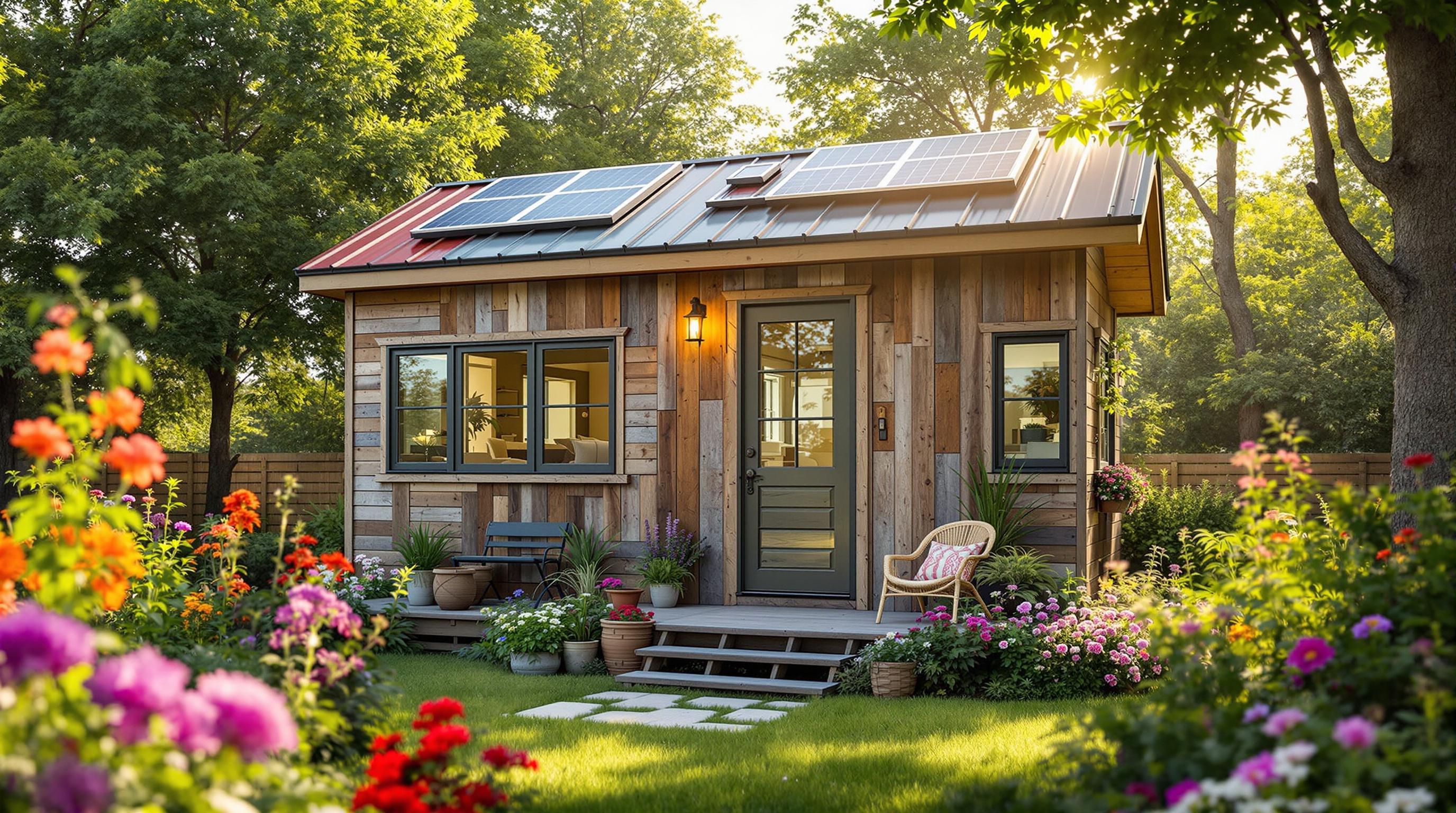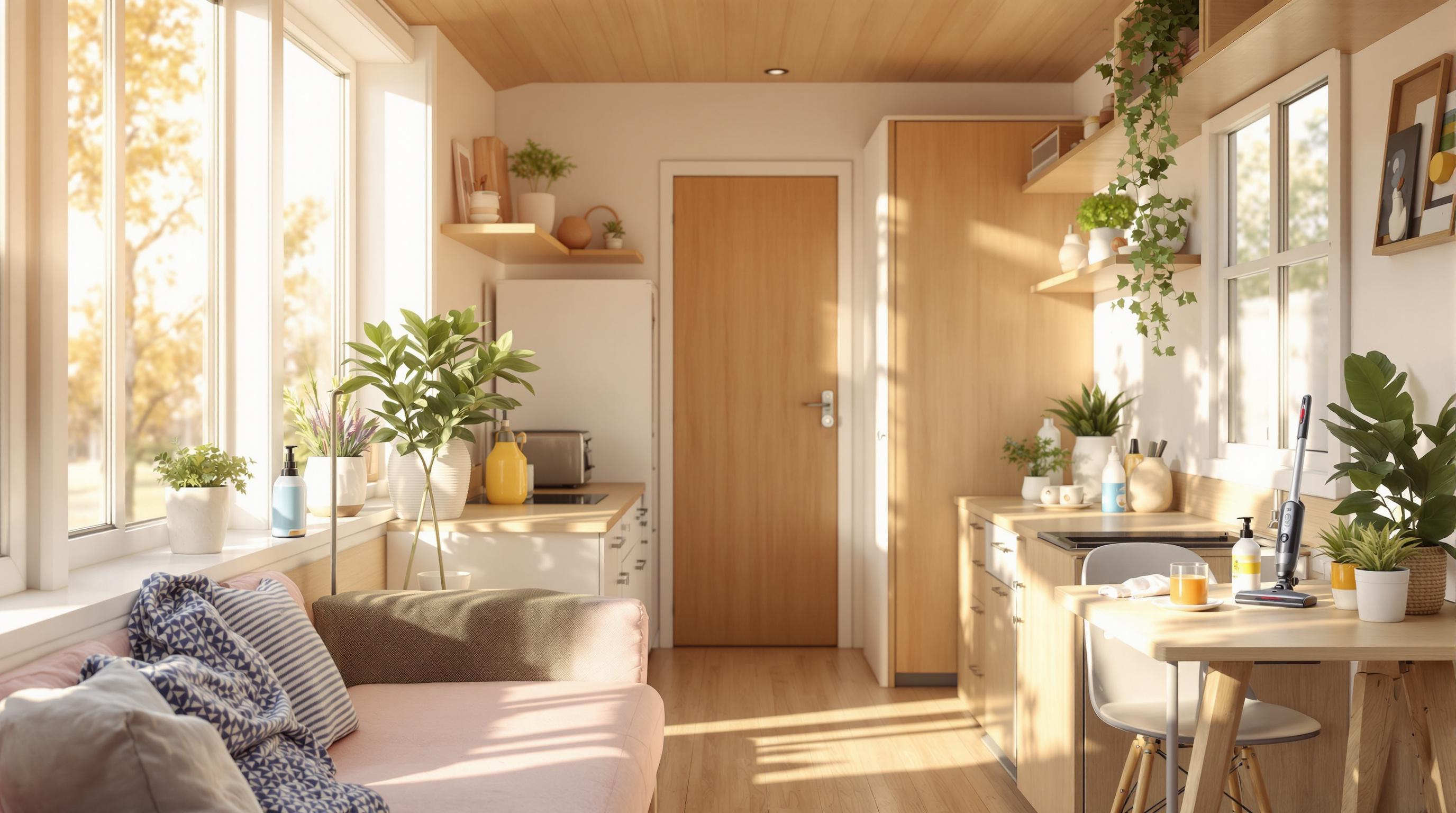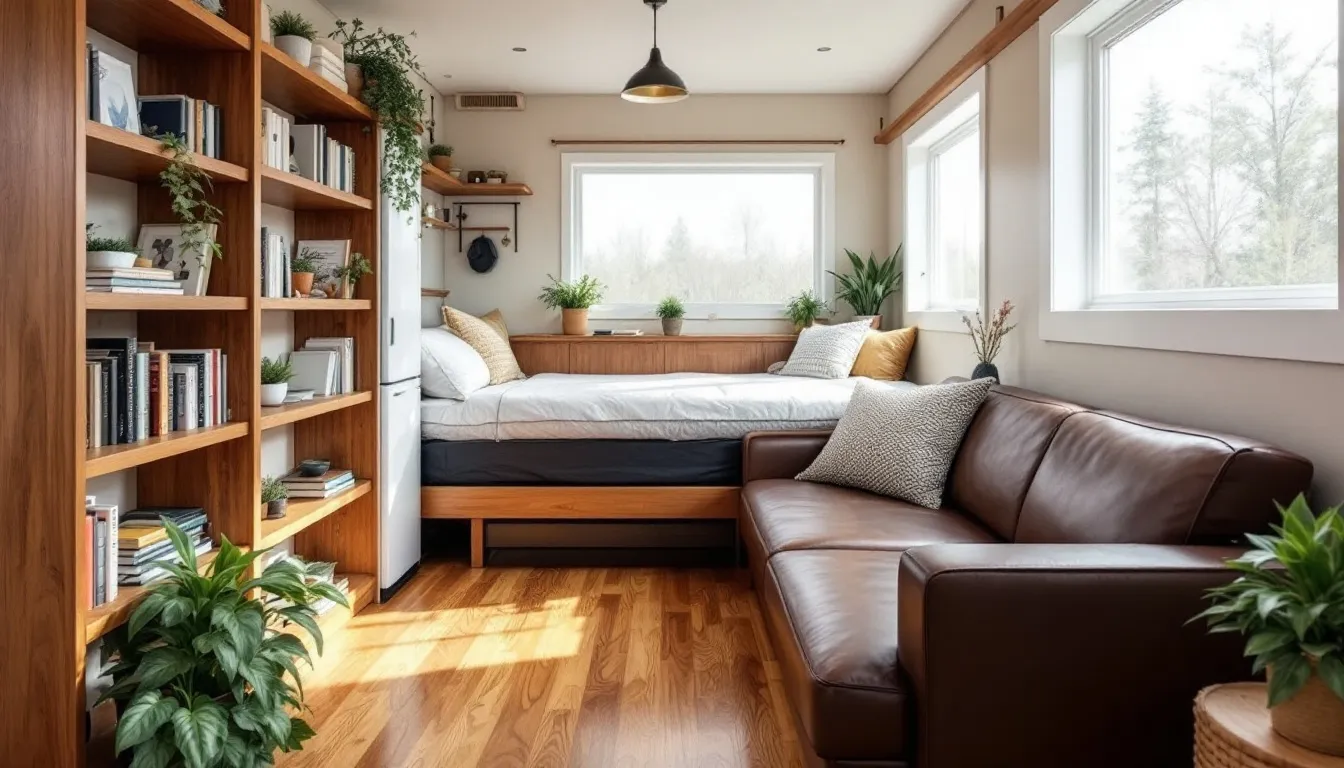Want to build a tiny house in Wisconsin? Here's what you need to know:
- Tiny houses must be at least 120 square feet in Wisconsin
- Costs typically range from $40,000 to $90,000
- Local laws vary widely - always check your specific area first
- You'll need proper permits, inspections, and possibly certifications
Key steps to build your tiny home:
- Check local zoning laws and get permits
- Choose a layout and foundation type
- Select weather-appropriate materials
- Build the structure and install utilities
- Finish interior and exterior
- Pass final inspections
Quick comparison of tiny house rules by county:
| County | Tiny Houses Allowed? | Size Requirements |
|---|---|---|
| Dane | Yes (as ADUs) | Up to 150 sq ft |
| Barron | Yes | Has tiny village |
| Milwaukee | Yes | Zoning unclear |
| Kenosha | No | 800 sq ft minimum |
Building a tiny house takes work, but can be very rewarding. With careful planning, you could be living tiny in Wisconsin before you know it.
Related video from YouTube
Getting Started: Laws and Planning
Building a tiny house in Wisconsin? You'll need to tackle laws, permits, and budgeting first. Let's break it down.
Local Laws and Rules
Wisconsin's tiny house rules are all over the place. They change depending on where you are in the state.
Here's the deal:
- Wisconsin says you need at least 120 square feet for a room you can live in.
- But counties have their own ideas:
- Dane County? They're cool with tiny homes as ADUs up to 150 square feet.
- Barron County? They're even more chill. They've got Wisconsin's first tiny house village.
- Kenosha County? Not so much. They want houses to be at least 800 square feet.
Here's a quick look at some counties:
| County | Can You Build a Tiny House? | What's the Deal? |
|---|---|---|
| Dane | Yep (as ADUs) | No bigger than 150 sq ft |
| Barron | Yep | They've got a tiny house village |
| Milwaukee | Yep | But zoning's a bit fuzzy |
| Kenosha | Nope | Houses must be at least 800 sq ft |
Always check with your local zoning folks. Rules can change.
Getting Your Permits
Want to build legally? You need permits. Here's how to get them:
- Do your homework. Look into local building codes and zoning laws.
- Talk to your local building authority. They can help.
- Make plans that follow the Wisconsin Uniform Dwelling Code.
- Send in your permit applications. Include site plans and construction drawings.
"Even tiny houses need to be safe to live in, whether they move or not." - TinyHouseMe
Building a tiny house on wheels? You might need an RVIA certificate from the manufacturer. And you'll need to find out where you can park it legally.
Setting Your Budget
In Wisconsin, a tiny house usually costs between $40,000 and $90,000. Here's a rough breakdown:
| What You're Paying For | How Much It Might Cost |
|---|---|
| Materials | $15,000 - $30,000 |
| Labor (if you're not DIY-ing) | $10,000 - $25,000 |
| Setting Up Utilities | $5,000 - $10,000 |
| Permits and Inspections | $1,000 - $3,000 |
| Land (if you're buying) | Varies a lot |
Pro Tip: Think about insulation and heating. Wisconsin winters are no joke. You might spend more upfront, but you'll save in the long run.
Planning Your House
You've handled the legal stuff. Now comes the fun part: planning your tiny house. Let's dive into the key steps to make your Wisconsin tiny home a reality.
Choosing Your Layout
In tiny houses, every inch matters. Here's how to maximize your space:
- Start with a bubble diagram to visualize each area.
- Sketch ideas on graph paper (1 square = 1 foot).
- Consider an open floor plan for flexibility and a spacious feel.
Tip: Try SketchUp, a free 3D modeling program, to create a digital layout.
Popular tiny house layouts compared:
| Layout Type | Pros | Cons |
|---|---|---|
| Open concept | Spacious, versatile | Less privacy |
| Loft bedroom | Maximizes floor space | Requires climbing |
| Main floor bedroom | Easy access | Takes up living space |
| Multi-purpose rooms | Space-efficient | Needs clever design |
Your layout should fit your lifestyle. Work from home? Include an office space. Love cooking? Prioritize a functional kitchen.
Picking Your Base
In Wisconsin, your tiny house base needs to handle harsh winters and meet local rules. Main options:
1. Trailer
Most common. Offers mobility but needs careful weight planning.
2. Slab foundation
Cost-effective but not ideal for Wisconsin's freezing temps.
3. Crawlspace foundation
Some protection from elements and easier utility access.
4. Basement foundation
Great for cold climates but pricier (up to $30,000).
For Wisconsin's climate, think about a frost-protected shallow foundation (FPSF). It uses insulation to stop ground freezing - perfect for tiny homes in cold areas.
"Any foundation can work in cold climates with careful planning, material selection, and steps to guard against freezing temps." - Leah Leitow, Content Writer
Building Materials
Picking the right materials is key, especially in Wisconsin's climate. Consider:
- Insulation: Go for high R-value materials like spray foam or rigid foam.
- Framing: Use 2x4 studs for walls, maybe 2x6 for extra insulation space.
- Roofing: Metal roofs are popular - durable and light.
- Siding: Choose weather-resistant options like fiber cement or vinyl.
Essential materials and estimated costs:
| Material | Estimated Cost | Notes |
|---|---|---|
| Lumber | $3,000 - $5,000 | Prices vary, buy off-season if possible |
| Insulation | $1,500 - $3,000 | Higher cost = better R-value |
| Roofing | $1,000 - $3,000 | Metal is durable but pricier |
| Siding | $2,000 - $4,000 | Include installation costs |
| Windows & Doors | $2,500 - $5,000 | Energy-efficient options cost more, save later |
Tip: Check out reclaimed materials to save money and add character. Try the ReStore by Habitat for Humanity in Milwaukee for good finds.
sbb-itb-2ef3f3a
Building Steps
You've planned your tiny house. Now it's time to build. Here's how to turn your Wisconsin tiny home dream into reality.
Setting Up Your Site
Start by prepping your land and laying a solid foundation.
Pick a level spot with good drainage. Clear the area, level the ground, and mark spots for utilities. For Wisconsin's harsh winters, consider a frost-protected shallow foundation (FPSF).
"A good tiny home begins with a flawless foundation, which is custom fabricated using high-quality steel." - Northern Tiny Living
Building the Structure
With your site ready, build the frame and walls.
Attach floor joists to your foundation or trailer. Build and raise wall frames, making sure they're square and plumb. Set up roof trusses, then cover walls and roof with plywood or OSB. Install windows and doors, sealing them well to keep out Wisconsin's cold air.
For tiny houses on wheels, Northern Tiny Living notes: "This particular model called for heavier materials and so we created a trailer frame with three axels."
Adding Water and Power
Now, set up your utilities.
| Utility | On-Grid Option | Off-Grid Option | Estimated Cost |
|---|---|---|---|
| Water | City water connection | Well or rainwater system | $1,000 - $5,000 |
| Power | Standard electrical hookup | Solar panels with battery | $2,000 - $10,000 |
| Sewage | City sewer connection | Composting toilet or septic system | $500 - $5,000 |
For a 24' tiny home, plumbing typically costs about $1,000. This can vary based on your water lines and fixture choices.
Finishing Inside and Out
The final stretch involves completing both exterior and interior work.
For the exterior, install siding (fiber cement is durable), add roofing (metal roofs are popular), and apply weatherproofing. Inside, install insulation (R-21 in walls and floors, R-35 in the ceiling), add walls and ceiling, install flooring, and set up kitchen and bathroom fixtures. Finish with paint, decor, appliances, and storage solutions.
"For additional weatherproofing, we add a layer of 'house-wrap' over our plywood sheathing." - Northern Tiny Living
Building in winter can have perks. Demlang Builders points out, "While snow isn't everyone's friend, there are pros to being able to shovel a job site clear, as opposed to waiting for it to dry out."
Final Checklist
You've built your tiny house in Wisconsin. Now let's wrap things up.
Getting Inspections
Passing inspections proves your tiny house is safe and legal. Here's how to ace them:
- Schedule early: Call your local building department as soon as you're ready.
- Know what they'll check: Inspectors look at everything from foundation to final details.
| Area | What They Check |
|---|---|
| Foundation | Stability, drainage |
| Framing | Load transfer, headers, anchoring |
| Plumbing | Under-floor and above-floor systems, testing |
| Electrical | Circuits, protection, proper wiring |
| Energy | Insulation in floors, walls, ceilings |
| Final | Smoke detectors, egress, dimensions |
- Be prepared: Have all your paperwork ready, including building plans and permits.
- Fix issues fast: If the inspector finds problems, address them quickly and schedule a re-inspection.
"For a better chance for placement, each home should be inspected at every stage of construction by a qualified impartial third-party inspector." - Noah RDI
Insurance and Papers
Protect your tiny house investment:
- Get the right insurance: Standard homeowners insurance won't work. You need RV insurance for mobile tiny houses or manufactured home insurance for stationary ones.
- Shop around: Some companies specialize in tiny house insurance. Compare quotes.
- Update your policy: Make sure it covers everything in your tiny space.
- Keep records: Save all receipts, contracts, and inspection reports. You might need them later.
Making it Official
Time to make your tiny house legit:
- Get certified: Most tiny houses need certification to prove they meet safety standards.
| Certification Type | When You Need It |
|---|---|
| RVIA (for mobile tiny houses) | If your house is on wheels |
| ANSI 119.5 (for park models) | For stationary tiny houses |
- Register your tiny house: If it's on wheels, you'll need a VIN number and a title (like for a car).
- Check local rules: Some areas have specific tiny house regulations. Make sure you comply.
- Get your Certificate of Occupancy: This is your official green light to move in. The building inspector issues this after your final inspection.
"Certification allows consumers to confidently purchase products certified to address their specific needs." - Mike Luna, NTA
Wrap-Up
Building a tiny house in Wisconsin? It's exciting, but you need to plan carefully. Here's what you need to know:
Wisconsin allows tiny houses, but rules change depending on where you are. Always check local laws before you start building.
In Wisconsin, your tiny house must be at least 120 square feet and have one livable room. Some counties have extra rules.
Here's a quick look at tiny house rules in different counties:
| County | Tiny House Rules |
|---|---|
| Dane | OK as ADUs up to 150 sq ft |
| Barron | More relaxed, has first tiny house village |
| Milwaukee | Allowed, but zoning is unclear |
| Kenosha | Not allowed |
Cost-wise, expect to spend between $40,000 and $90,000. If you're handy, you might build one for as low as $30,000.
Don't forget about safety. If your house is mobile, look into RVIA certification. For stationary homes, consider ANSI 119.5 certification.
What's Next?
After you finish building:
1. Get inspected: Your local building department needs to check your house.
2. Get insured: You'll need special insurance for your tiny home.
3. Set up utilities: Here's what it might cost:
| Utility | Possible Cost |
|---|---|
| Water | $1,000 - $5,000 |
| Power | $2,000 - $10,000 |
| Sewage | $500 - $5,000 |
4. Move in: Once you pass inspections and get your Certificate of Occupancy, you're good to go!
5. Join the community: Think about connecting with other tiny house owners. The Canoe Bay Escape Village in Rice Lake is a cool tiny house resort you might want to check out.
Building a tiny house isn't just about the house - it's about living with less. As one tiny house owner put it: "We absolutely think that building our tiny house was worth it. Owning our own tiny home is such an amazing thing."
FAQs
How much does it cost to build a custom tiny house?
Building a custom tiny house in Wisconsin isn't cheap. But it's not as expensive as a traditional home either. Here's a quick breakdown:
| Size | Length | Cost |
|---|---|---|
| Small (90 – 250 SF) | 12' – 20' | $30,000 – $70,000 |
| Medium (250 – 300 SF) | 22' – 28' | $50,000 – $125,000 |
| Large (300 – 400 SF) | 30' – 40' | $80,000 – $150,000 |
| Extra-large (400 – 600 SF) | > 40' | $100,000 – $200,000+ |
Want to save some cash? Go DIY. You could build your own tiny house for $10,000 to $30,000. But remember, professional builds come with expertise and certifications. These might be necessary in some areas.
What are the rules for tiny houses in Wisconsin?
Wisconsin has some specific rules for tiny houses:
- They must be at least 120 square feet
- You need at least one habitable room
- Some local areas might require 150-200 square feet
But here's the catch: rules can vary A LOT between counties and cities. For example, Dane County says "sure" to tiny homes as Accessory Dwelling Units (ADUs) up to 150 square feet. But Kenosha County? They want houses to be at least 800 square feet.
So, what should you do? Check with your local zoning authority BEFORE you start building.
Can I put a tiny home on my property in Wisconsin?
Yes, you can. But (there's always a but, right?) you need to follow some rules:
- Your tiny house must meet state building codes and local zoning laws
- It needs a permanent foundation (unless you're in an area zoned for mobile tiny homes)
- Some places only allow tiny houses as ADUs on properties with existing homes
Barron County is known for being tiny house-friendly. They even have Wisconsin's first tiny house village! But many cities have stricter rules.
"Tiny houses are legal in Wisconsin if they are built following the state's building codes and zoning regulations." - Wisconsin Tiny Home Rules & Regulations
Bottom line? Always check with your local building department before you start your tiny house project. It's better to know the rules upfront than to face problems later.



